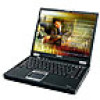Toshiba Tecra M2 Tecta M2 User's Guide (PDF) - Page 115
Hot swapping, Using SD® cards, Hot swapping precautions
 |
View all Toshiba Tecra M2 manuals
Add to My Manuals
Save this manual to your list of manuals |
Page 115 highlights
115 Learning the Basics Using SD® cards Hot swapping With PC Cards, you can replace one PC Card with another while the computer is on. This is called "hot swapping." Hot swapping precautions Although you can insert a PC Card at any time, remember not to remove a card while it is in use. Otherwise, you could lose valuable information. For example: ❖ Do not remove a hard disk card while the system is accessing it. ❖ Do not remove a network card while you are connected to a network. ❖ Do not remove a SCSI card while any of the SCSI devices connected to it are operating. Before removing a PC Card, stop it by clicking the Safely Remove Hardware icon on the System tray. After the PC Card is stopped, it is safe to remove. Using SD® cards If you do not already have a SD® card inserted in the computer, you may do so following the procedures outlined in "Inserting an SD® card" on page 88. Important: Do not use the Copy Disk function for SD cards. In order to copy data from one SD card to another, use the following procedure: 1 Format the target SD card in the same format as the source SD card. 2 Insert the source SD card. 3 Create a temporary folder on the hard disk drive.















